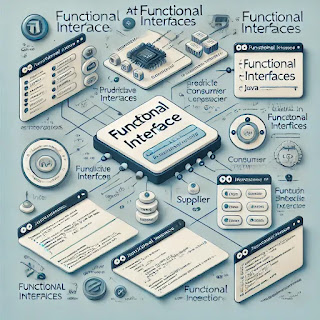Functional Interfaces in Java
Introduction
Functional interfaces in Java play a crucial role in enabling functional programming by allowing the use of lambda expressions and method references. A functional interface is an interface that contains exactly one abstract method, making it a perfect target for lambda expressions.
This article will provide a deep dive into functional interfaces, their built-in types, custom implementations, and practical examples to help understand their significance.
What is a Functional Interface?
A functional interface is an interface with exactly one abstract method. However, it can have multiple default or static methods. Functional interfaces are annotated with @FunctionalInterface, but this annotation is optional.
Example of a Functional Interface
@FunctionalInterface
interface MyFunctionalInterface {
void displayMessage(String message);
}
Since the interface contains only one abstract method, it qualifies as a functional interface.
Why Use Functional Interfaces?
-
Simplifies Code - Enables writing concise and readable code using lambda expressions.
-
Supports Functional Programming - Facilitates a functional programming style in Java.
-
Improves Code Reusability - Can be reused with different implementations without creating multiple classes.
-
Boosts Performance - Lambda expressions reduce overhead by avoiding anonymous class creation.
Built-in Functional Interfaces in Java
Java provides several pre-defined functional interfaces under java.util.function package. Some of the key ones are:
1. Predicate
Represents a boolean-valued function that tests an input.
import java.util.function.Predicate;
public class PredicateExample {
public static void main(String[] args) {
Predicate<Integer> isEven = num -> num % 2 == 0;
System.out.println(isEven.test(4)); // Output: true
System.out.println(isEven.test(7)); // Output: false
}
}
2. Function<T, R>
Takes one argument and returns a result.
import java.util.function.Function;
public class FunctionExample {
public static void main(String[] args) {
Function<String, Integer> stringLength = str -> str.length();
System.out.println(stringLength.apply("Functional Interface")); // Output: 19
}
}
3. Consumer
Represents an operation that takes an input and returns nothing.
import java.util.function.Consumer;
public class ConsumerExample {
public static void main(String[] args) {
Consumer<String> printMessage = message -> System.out.println(message);
printMessage.accept("Hello, Functional Interface!");
}
}
4. Supplier
Takes no input and produces a result.
import java.util.function.Supplier;
public class SupplierExample {
public static void main(String[] args) {
Supplier<Double> randomValue = () -> Math.random();
System.out.println(randomValue.get());
}
}
5. BiFunction<T, U, R>
Takes two arguments and returns a result.
import java.util.function.BiFunction;
public class BiFunctionExample {
public static void main(String[] args) {
BiFunction<Integer, Integer, Integer> addNumbers = (a, b) -> a + b;
System.out.println(addNumbers.apply(5, 10)); // Output: 15
}
}
Creating Custom Functional Interfaces
In addition to built-in functional interfaces, we can create custom ones to define specific behavior.
Example:
@FunctionalInterface
interface Calculator {
int operate(int a, int b);
}
public class FunctionalInterfaceExample {
public static void main(String[] args) {
// Using Lambda Expression
Calculator addition = (a, b) -> a + b;
Calculator multiplication = (a, b) -> a * b;
System.out.println("Addition: " + addition.operate(5, 3)); // Output: 8
System.out.println("Multiplication: " + multiplication.operate(5, 3)); // Output: 15
}
}
Functional Interfaces and Lambda Expressions
Since functional interfaces contain only one abstract method, they can be used with lambda expressions to provide concise implementations.
Example:
@FunctionalInterface
interface Greeting {
void sayHello(String name);
}
public class LambdaExample {
public static void main(String[] args) {
Greeting greet = name -> System.out.println("Hello, " + name);
greet.sayHello("Alice"); // Output: Hello, Alice
}
}
Functional Interfaces in Streams API
Functional interfaces are widely used in the Streams API, which simplifies bulk data processing in Java.
Example using Predicate and Streams:
import java.util.Arrays;
import java.util.List;
import java.util.function.Predicate;
public class StreamExample {
public static void main(String[] args) {
List<Integer> numbers = Arrays.asList(10, 15, 20, 25, 30);
Predicate<Integer> isEven = num -> num % 2 == 0;
numbers.stream().filter(isEven).forEach(System.out::println);
}
}
Output:
10
20
30
Best Practices for Functional Interfaces
-
Always use
@FunctionalInterfaceannotation to ensure the interface has only one abstract method. -
Prefer built-in functional interfaces instead of creating custom ones whenever possible.
-
Use meaningful method names to improve code readability.
-
Avoid state changes inside lambda expressions to maintain purity.
-
Combine multiple functional interfaces using
andThen(),compose(), etc.
Conclusion
Functional interfaces in Java empower functional programming by enabling the use of lambda expressions and method references. Java provides several built-in functional interfaces like Predicate, Function, Consumer, and Supplier, which streamline data processing and improve code readability.
By understanding and effectively utilizing functional interfaces, developers can write concise, flexible, and maintainable code that aligns with modern Java best practices.
Sign up here with your email

ConversionConversion EmoticonEmoticon